Anirudh Kanisetti
What explains the Great Divergence between Indian and foreign military powers?
Inthe 10th and 11th centuries, Europe was very much the backwater of the civilised world. In the Middle East, the Islamic Golden Age of scientific innovation was reaching a crescendo with advances in everything from algebra to the properties of light. In China under the Song dynasty, paper money was being experimented with, and more importantly, gunpowder weaponry was being incorporated into the military.
Historians claim that when these advances reached Europe, the existence of a “competitive state system” exerted a selective pressure on the evolution of technology. If one state came up with an advance, other states would copy it or improve it, and so on. The historian Tonio Andrade has shown that a similar process happened in China as well (which was, historically, far less united and peaceful than we normally assume).
Owing to India’s geographical diversity, it has historically been difficult for a single unified empire to emerge. One would expect that the resulting system of competing states should have stoked extraordinary military advances, especially so because India was deeply integrated into global trade and must have known about the latest scientific advances. Why, then, does it seem that India stagnated while the rest of the world innovated? Why was it that Indian states at the turn of the 12th century were defeated by Turkic invaders?
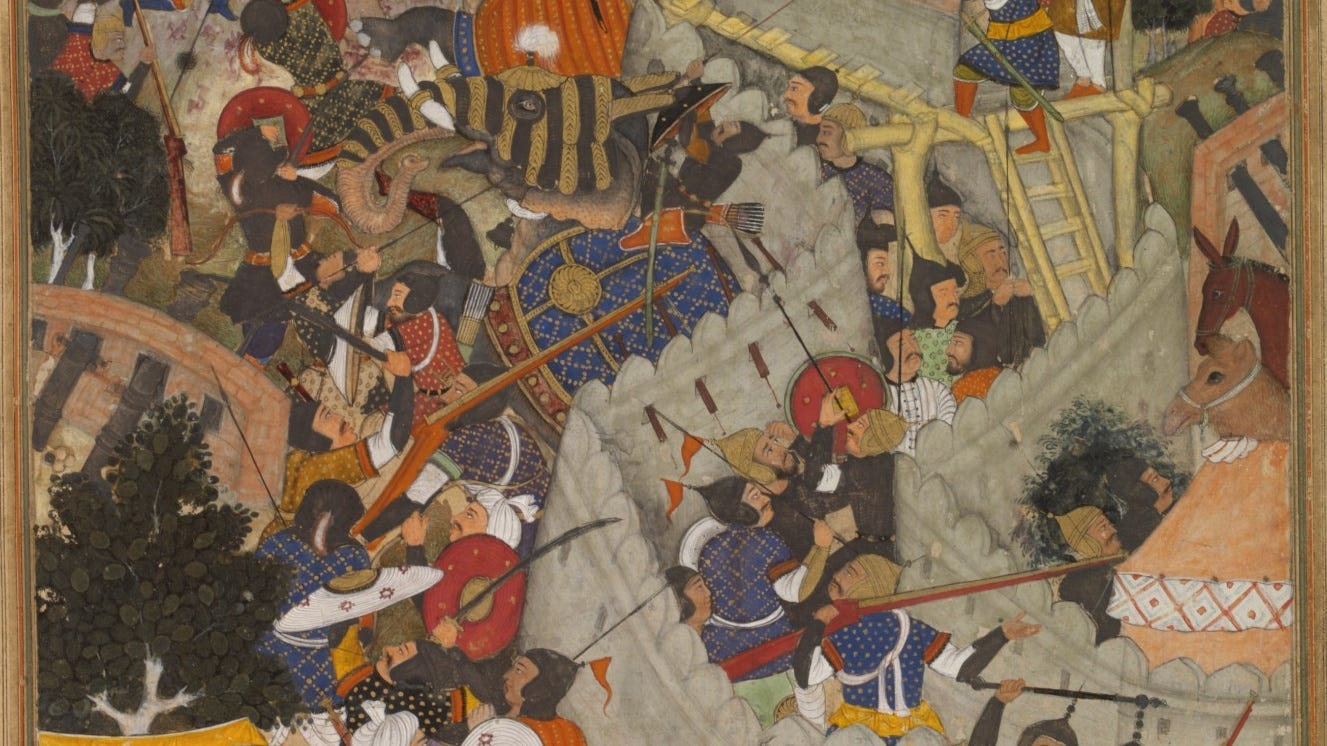 A Mughal painting depicting musketry, elephants, and fortification in a violent siege. Source: Wikimedia Commons
A Mughal painting depicting musketry, elephants, and fortification in a violent siege. Source: Wikimedia Commons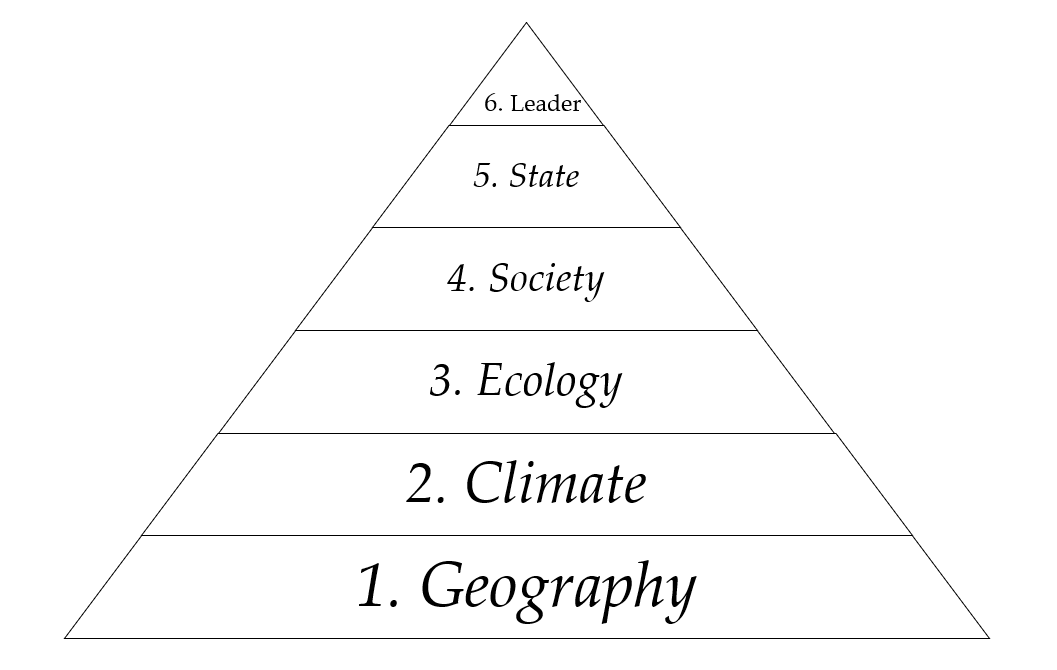 The W.T.F. or World Theory Framework, so named for the feeling this author had when he came up with it.
The W.T.F. or World Theory Framework, so named for the feeling this author had when he came up with it.
I propose a general framework for the understanding of historical phenomena, which I christen the W.T.F., or “World Theory Framework”. I will analyse the phenomenon of India’s relative lack of military innovation using the framework.
Level 1,2,3 Causes: Geographical, Climactic, Ecological
I’ve argued earlier that India’s strategic geographic position has brought in trade from both East and West. In addition, the peninsula is in the ideal position to capture the annual monsoonwinds coming in from the South-West. Hemmed in by the Himalayas, the winds deposit their moisture over the subcontinent before heading back.
This leads to a sustained rainy season on which much of Indian agriculture — even today — is dependent. In addition, India’s latitudinal position leads to warm, sunny weather. As a result, India’s geography ensures a humid, tropical climate, ideal for the growth of palm trees as well as for insects which eat them. It also makes the construction of transport infrastructure difficult, meaning that pre-modern states could not be as centralised or massive as in other, more temperate areas like Europe or China.
The problem with such a climate and ecology is that it makes it ridiculously difficult to maintain written records — especially if writing is being done on palm leaves, as it was in ancient India. If a text was to be preserved, it would have to be copied out into a fresh manuscript roughly every generation or so. Considering the every-expanding corpus of knowledge, it would have been necessary to maintain a massive organisation of scribes to do this on a sustained basis. Any degree of political instability in a state, then, would have been disastrous because of the amount of knowledge that would not be preserved for lack of resources.
Level 4 Causes: Society
Perhaps partially to deal with this problem, or because the nomadic origins of the Indo-Aryans, India had a strong culture of oral transmission, but this was used (as far as we know) primarily for sacred knowledge. Sanskrit dissertations and theses would have been spread by memory across the subcontinent, allowing for a wide degree of argument and refinement, but Sanksrit was not the language of the productive classes.
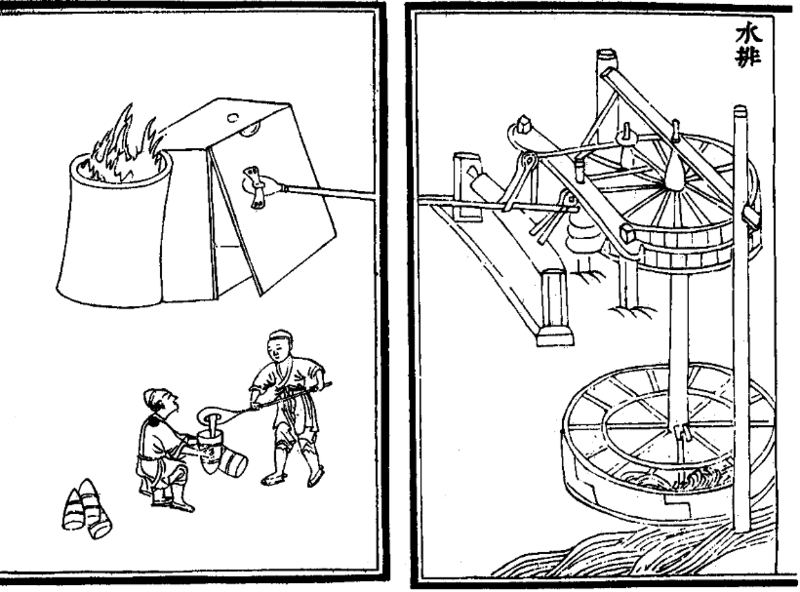 Chinese smelting and a hydraulic wheel, from a Yuan dynasty treatise. Source: Wikimedia Commons
Chinese smelting and a hydraulic wheel, from a Yuan dynasty treatise. Source: Wikimedia Commons
Perhaps steel manufacturing and textile weaving knowledge too were transmitted orally within family or caste groups, but these are less efficient, in terms of dissemination, than written texts. It takes a great deal more effort to train a craftsman orally as opposed to handing out assembly-line manufacturing texts.
Compare this to China. During the Song Warring States Period (late 10th — 11th century CE), three large states competed ruthlessly. When a city was sacked, its library, which would have been carefully maintained by its former owner, would have been carted away by the victors. Technology ranging from military drill to steel and paper manufacturing would have been learned by their scholars, and used in state-owned assembly lines.
In India, the only comparable way to extract such information would have been to induce experts to teach it — and perhaps even this was restricted by caste and guild monopolies on knowledge, which relatively decentralised Indian states could not have easily broken. While, in the short term, this allowed extremely high-quality production which was good for trade, it imposed limits of scale and made innovation difficult. Think of it as a system of eternal patents — which, modern researchers have argued, impede scientific progress.
Level 5 Causes: The State and the State System
 As discussed in earlier articles, ancient Indian states were not highly centralised, allowing for a very high degree of local autonomy. While this is great for prosperity, it might not always be great for innovation and scientific progress, especially given the social factors discussed.
As discussed in earlier articles, ancient Indian states were not highly centralised, allowing for a very high degree of local autonomy. While this is great for prosperity, it might not always be great for innovation and scientific progress, especially given the social factors discussed.
China in the Warring States Period. Source: Wikimedia Commons
Let’s consider China again, for contrast. Possibly, the relative riverine interconnectedness of the geography, in addition to cultural concepts, allowed for the creation of centralised states through competition in the early Warring States Period (which resulted in the formation of the first Chinese Empire under Shi Huangdi).
Such centralised Chinese states which recognised the importance of innovation to defeat their rivals could invest in R&D, hire experts, and reward inventors. They could also create manufactories to use and spread the technology. By interacting with their rivals via trade and war, the technology would be further refined. None of them would be able to overthrow the status quo, but they would push each other to progress. If any of them fell behind, it would be consumed by the others. This could be called a “high-productivity competitive stability”. A similar pattern emerges in Europe as states begin to centralise in the 15th century.
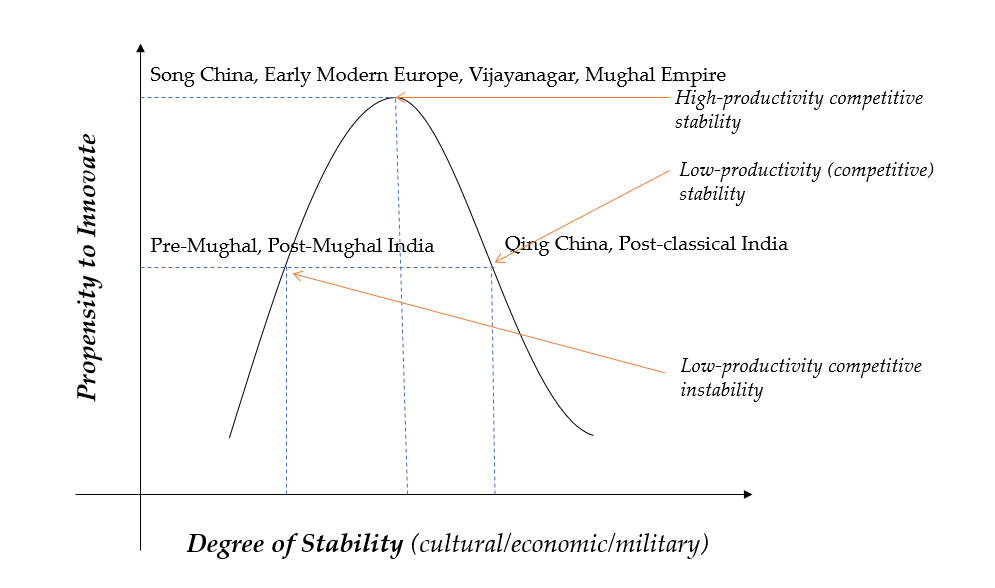 A proposed explanation for a society’s propensity to innovate. Post-classical India was characterised by a relatively high degree of economic prosperity and cultural stability, possibly reducing the imperative to innovate.
A proposed explanation for a society’s propensity to innovate. Post-classical India was characterised by a relatively high degree of economic prosperity and cultural stability, possibly reducing the imperative to innovate.
In India, the high degree of geographical and cultural variance practically mandated the creation of decentralised states. Broad ideas of Sanskritic kingship, based on the extraction of tribute and acknowledgement of suzerainty, developed, but these were probably a reaction to the status quo, as opposed to causing it. Therefore, while being unable to overpower their rivals, as in China, states also lacked the resources or inclination to innovate. If a state was defeated, it would simply pay tribute and break free when it could. There was no existential threat to its existence. Even if extraordinary military advances were made abroad, there was no pressing need to upset the Indian status quo. This led to a “low-productivity competitive stability”.
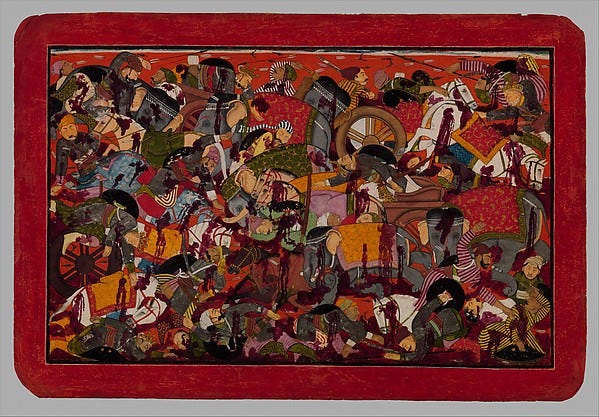 “The Nightmare Dream of a King: The Fearsome Aftermath of the Battle of Kurukshetra,” from the Metropolitan Museum of Art. Indian states were no strangers to violence and bloodshed, but preferred suzerainty to sovereignty until the early modern period.
“The Nightmare Dream of a King: The Fearsome Aftermath of the Battle of Kurukshetra,” from the Metropolitan Museum of Art. Indian states were no strangers to violence and bloodshed, but preferred suzerainty to sovereignty until the early modern period.
To extend the concept, a highly fragmented system of small states would not have the resources to innovate, and would also stagnate. That degree of stability could be “reset” by, say, a foreign invasion which creates a power vacuum. This could be the dynamic that explains the innovative nature of the Vijayanagara Empire and the Mughal Empire, both of which emerged in relative power vacuums.
It should also be noted that we cannot definitively say that India was notinnovative. There is a serious dearth of material on ancient India, with many Sanskrit texts in a state of neglect, of which only a tiny proportion have been translated. In addition, some exceptions, such as the Chola Empire of South India using flamethrowers (attested to in Southeast Asian murals), have been recorded, but the reliability is questionable.
Level 6: Losing Battles and Winning Wars
Leadership is only the top rung of the World Theory Framework, and I will argue in later articles that the 5 “lower” rungs are far more important in determining the broad trends of history. Leadership can help channel, speed up, or slow down the processes to some extent, and can sometimes kick off cascading effects. But it is rare for it to be able to change a deep-rooted trend.
That said, there is one aspect in which leadership is indeed vital: in winning battles (not necessarily wars). This, I believe, more than just a lack of innovation, is the reason that Indian states were apparently taken by surprise by the Turkic invasions of the 12th century.
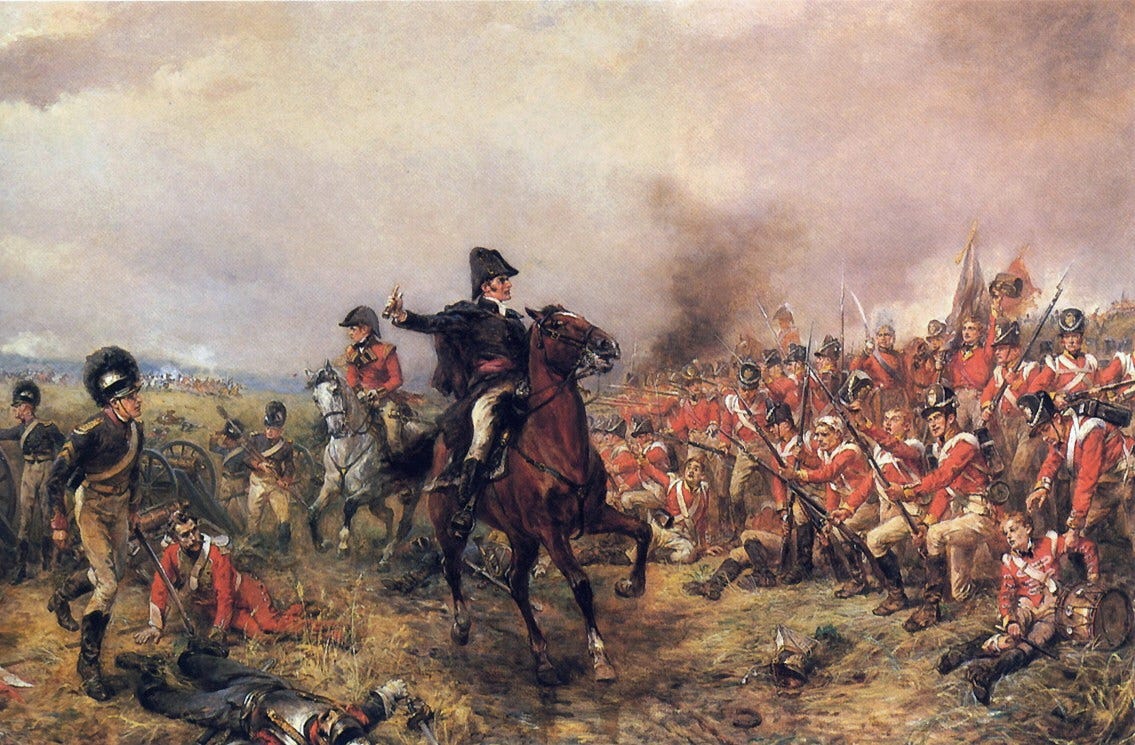 The Duke of Wellington at the Battle of Waterloo, 1815. According to the researcher’s simulations, his absence would have increased the odds of Napoleon winning from 18% to 79%. Image Source: Wikimedia Commons
The Duke of Wellington at the Battle of Waterloo, 1815. According to the researcher’s simulations, his absence would have increased the odds of Napoleon winning from 18% to 79%. Image Source: Wikimedia Commons
In a 2002 discussion paper, researchers from IZA Bonn analysed a large dataset of battles ranging from the 17th to the 19th century in order to understand the determinants of battlefield success. By far the most important predictor, they found, is quality of leadership. This is followed by force ratio, surprise, morale, logistics, and intelligence.
A large army led by an incompetent or inexperienced leader can be defeated by a smaller army led by a veteran general, especially one with surprise on his side. This could be why Muhammad Ghori won the Second Battle of Tarain in1192 against a disunited coalition of Rajputs, leading to the creation of the Delhi Sultanate. A similar dynamic explains the success of the veteran general and future Mughal Emperor Zahir-ud-din Babur at the Battle of Panipat, and the Maratha ruler Shivaji’s guerilla tactics. In most cases, there was fierce resistance by the opposing side, which was prodded into innovation.
Consider Vijayanagar and the Bahmani Sultanate. Initially, buoyed by foreign mercenaries hired using its integration into the Arab/Persian global network as well as by militant Sultans, the Bahmanis had the upper hand. However, after the reforms of and under the generalship of the emperor Krishna Deva Raya, Vijayanagar turns the tables.
Despite the military successes and failures of these rulers, however, broader trends still proved more important. India proved to be remarkably assimilative towards all of its conquerors, enriching its own culture and art forms and quickly learning from them (until the conqueror became too large, powerful and peaceful, reducing the imperative to innovate).
At an even more macro level, the shift of the global economic centre of gravity and the deep-rooted nature of inefficient institutions (such as caste-based eternal knowledge patents) meant that, despite some changes, the gulf between India and the West was getting wider and wider, resulting in a skewed balance of power, eventually, colonisation. This Great Divergence has been compellingly analysed by Kaveh Yazdani in his India, Modernity and the Great Divergence (my review here).
Modern India would do well to realise the importance of innovation, in addition to taking cognizance of broader global and domestic socio-economic trends as outlined in the framework. In our ancient mistakes lie lessons for our present and future.
No comments:
Post a Comment